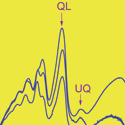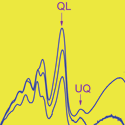Unexpected response
Pure bismuth holds a distinguished spot among elemental metals for its physical properties and uncommon electronic band structure. It is a semimetal with an extremely small Fermi surface, very low carrier density, and long mean-free-path, all of which combine to create an interesting situation: under a magnetic field of only 9 T the quantum limit is reached in which all electrons are confined to the lowest Landau level. Doping with antimony drives a semimetal-to-semiconductor transition and decreases the carrier density further. With a composition , bismuth becomes a topological insulator—an exotic state of matter predicted by theorists and recently observed in experiments (see [1]).
In very high magnetic fields, it is possible to reach the so-called ultraquantum regime in these materials: the electrons are still confined to the lowest Landau level, but their quantized orbits shrink to dimensions smaller than the Fermi wavelength. In a recent Rapid Communication appearing in Physical Review B, Arita Banerjee, Kamran Behnia, and coworkers from the Ecole Supérieure de Physique et de Chimie Industrielles in Paris, and colleagues in France and Japan, identify the quantum limit in semimetallic at only 3 T, a moderate and easily accessible field by modern laboratory standards. Similarly to what was found in bismuth, they report several anomalies in the transport properties that are difficult to explain. They observe an unexpected peak in the Nernst signal—the appearance of a transverse electric field in response to a longitudinal thermal gradient—at 6 T, twice the quantum field limit. (In contrast, peaks in the Nernst signal in the ultraquantum regime of elemental bismuth occurred at magnetic fields corresponding to half-integer (3/2, 5/2, and 7/2) multiples of the quantum limit field.)
These unexpected anomalies in are difficult to reconcile with current theoretical understanding and point to interesting many-body effects. – Alexios Klironomos
[1] S-C Zhang, Physics 1, 6 (2008).





